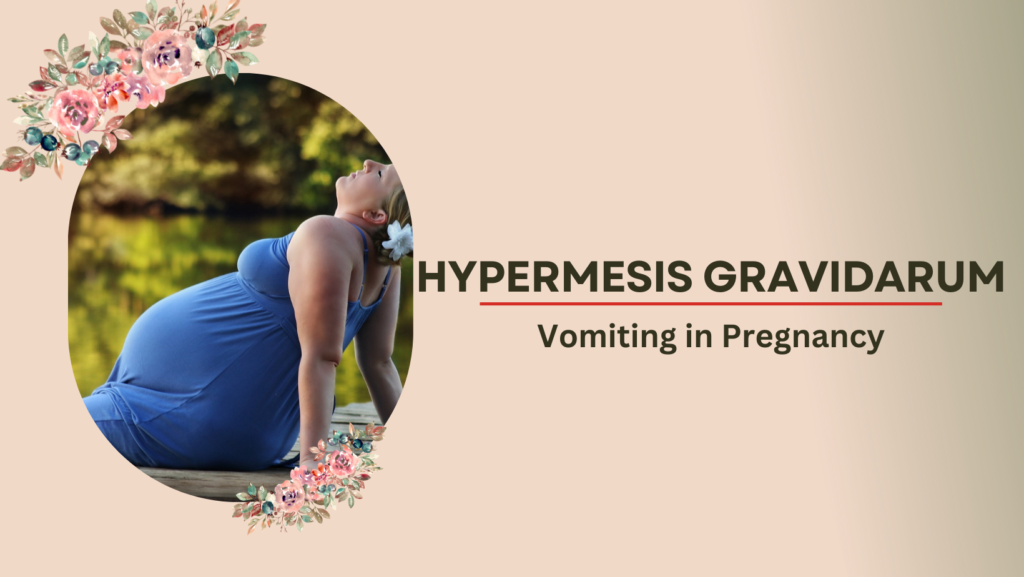Hyperemesis Gravidarum
Hyperemesis Gravidarum
Define hyperemesis gravidarum : It is a severe type of vomiting of pregnancy which has got deleterious effect on the health of the mother & / or incapacitates her in day to day activites.
We have described in article
Risk factors / Causes of hyperemesis gravidarum
Clinical Features of hyperemesis gravidarum
Investigation of hyperemesis gravidarum
Treatment of hyperemesis gravidarum
Complications of hyperemesis gravidarum
Cause of vomiting in pregnancy

Risk factors / Causes of hyperemesis gravidarum :
- It is mostly limited to the 1st trimester.
- It is more common in 1st pregnancy, with a tendency to recur again in subsequent pregnancies (15%).
- Younger age.
- Low body mass.
- H/O motion sickness or migraine.
- It has got a familial history : Mother & sisters also suffer from the same manifestation.
- It is more prevalent in hydatidiform mole and multiple pregnancies.
- It is more common in unplanned pregnancies but much less amongst illegitimate ones.
Management of hyperemesis gravidarum :
- Early : Vomiting occurs throughout the day & daily activities are curtailed. There is no evidence of dehydration or starvation.
- Late (moderate to severe) : Signs of dehydration and starvation are present.
Symptoms of hypermesis gravidarum :
1.Vomiting :
- Increase in amount and in frequency.
- Retching and nausea persist in between vomiting
- Vomitus may be coffee ground or even contained blood.
2. Normal activities are hampered, patient is confined to bed.
3. Diminished urinary output (even to the stage of oliguria).
4. Epigastric pain
5. Constipation
6. Symptoms of complications (Vitamin B1 deficiency) : May be present.
- Wernicke’s encephalopathy : Confusion, disorientation, visual abnormalities (e.g. diplopia)
- Korsakoff’s psychosis : Mental confusion with loss of recent memory
- peripheral neuritis / neuropathy : Tingling, numbness.
Sign of hyperemesis gravidarum :
1. Features of dehydration and ketoacidosis :
- Dry, Coated tongue
- Sunken eyes
- Acetone smell in breadth
- Tachycardia
- Hypotension
- Rise of temperature
2. Jaundice is a late features.
3. SIgn of vitamin B1 deficiency may present.
4. Per vaginal examination : confirms pregnancy.
Investigation of hyperemesis gravidarum :
1.USG Of lower abdomen :
- To confirm pregnancy and
- To exclude the other cause (H.mole & twin pregnancies).
2. Urine analysis : Small in quantity, dark color , high specific gravity with acid reaction, occasional presence of acetone with protein & bile pigment.
3. Blood : Hb%, TC, DC, ESR.
4. RBS.
5. S electrolyte
6. ECG.
Treatment of hyperemesis gravidarum :
A. General treatment :
- Urgent hospitalization.
- Nothing by mouth for at least 24 hours . Oral route (both medication & food should be used after significant improvement of the patient).
- Intravenous fluid : Electrolyte containing fluid is preferable. Cholera saline or Hartman’s solution (1L), 5% DA(1L) & 5% DNS (1L) are given @30 drops/min.
- Catheterization (in severe dehydration) : To monitor urine output. (usually catheterization is avoided in mild – moderate case: as there is chance of infection).
B.Specific treatment :
- Anti – emetic : Promethazine (25 mg I/M tds ) : Prochlorperazine (12.5 mg I/V tds) : Ondansetron (8 mg I/V bd or tds) : Metoclopramide 910 mg I/V tds).
- Hydrocortisone (100 mg I/V in the drip) : In a case with hypotension or in intractable vomiting. Oral prednisolone is also used in severe cases.
- Nutritional support : Vitamin B1, B6, & B12 combined preparation (I/V) or B complex (I/ V) & vitamin C injection (I/V) can be given.
Complications of hyperemesis gravidarum :
The majority of the clinical manifestation &/or complications are mostly due to dehydration and starvation with resulting ketoacidosis.
- Dehydration
- Shock
- Acute renal failure
- Electrolyte imbalance.
- Ketoacidosis
- Neurological complications :
- Wernicke’s encephalopathy (due to vitamin B1 deficiency)
pontine myelinolysis. - Korsakoff’s psychosis
- Peripheral neuropathy
- Retinal haemorrhage.
7. Jaundice.
8. Stress ulcer.
9. Biochemical : Hypoglycaemia, hypoproteinaemia, hypovitaminosis, & rarely hyperbilirubinaemia.
What are the biochemical changes occur in hyperemesis gravidarum ?
- Increase blood urea and uric acid.
- Hypoglycaemia
- Hypoproteinaemia.
- Hypovitaminosis.
- Hyperbilirubinaemia (rarely).
Cause of vomiting in pregnancy :
- Pre – eclampsia
- UTI
- Complicated DM
- Hypermesis gravidarum.
- Peptic ulcer disease (PUD).

You could certainly see your enthusiasm in the work you write. The world hopes for more passionate writers like you who aren’t afraid to say how they believe. Always go after your heart.
I have not checked in here for a while because I thought it was getting boring, but the last few posts are great quality so I guess I’ll add you back to my daily bloglist. You deserve it my friend 🙂
Thanks for helping out, fantastic information.
Only wanna remark that you have a very decent web site, I enjoy the design it really stands out.
I love what you guys are up too. This sort of clever work and coverage! Keep up the excellent works guys I’ve included you guys to our blogroll.